E – List # 3 : OUT OF JAIL
A Collection of True Crime , Pirated , and Otherwise Scandalous Books
E - List 3 Out Of Jail Catalogue(2)
[ Alsop, Richard, ed.] Narrative of the adventures and sufferings of John R. Jewitt ; only survivor of the crew of the ship Boston, during a captivity of nearly three years among the savages of Nootka Sound with an account of the manners, mode of living and religious opinions of the natives. Embellished with ten engravings. Printed for the Publisher : New York. [1815].
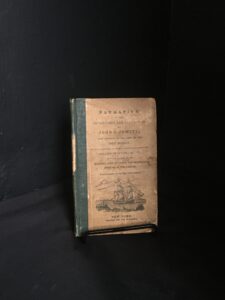
The later, expanded edition of Alsop’s description of the ill-fated voyage of John R Jewitt — armorer and blacksmith aboard the ship Boston.
Departing from New England in 1802, the ship arrived in Nootka Sound off today’s Vancouver Island in March, 1803, not long after the crew’s starving captain shot and killed an albatross. Following initially cordial relations with the local, English-comprehending Native people, disputes over trade relations and previous European abuses boiled over into violence.
All but one of the other crew members were killed, with the survivors taken as the tribe’s slaves until their rescue in 1805. John R Jewitt, an educated and curious observer, made note of many interesting cultural details from his time with the Nootka, including a Nootka to English key at the start of the work, and the transcription of a contemporary war song.
12mo, 166pp, original printed paper boards, green cloth spine with original title label. Wear to edges and corners, some scratches to faces. Corners bumped, lower rear corner bent. First free endpaper missing top for corner. Pages tanned and foxed. Ownership signature “H. Jacobs” on top and bottom margin of title page bleeding forward and backward into margins of the opposing ship portrait frontis and prior two endpapers as well as the following three pages. Very good condition.
$750
Bernard, Elder David. Light on Masonry : A Collection of All The Most Important Documents… William Williams, Genesee Street : Utica. 1829. Third edition.
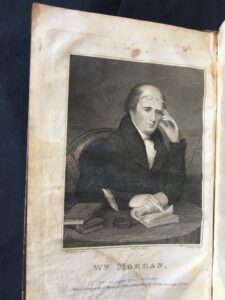
Written and published in upstate New York in the wake of the disappearance of William Morgan, Bernard ‘s Light on Masonry sought to exceed and expand on Morgan’s possibly fatal efforts to illuminate Freemasonry to outsiders.
In 1826, Morgan — a purported Freemason — announced his intention to publish Illustrations of Masonry, an expose of Masonic rituals, ceremonies, codes, and organizational structure. Following an apparent attempted arson carried out against his printer, Morgan was arrested on spurious charges and abducted from jail. After leaving in a carriage with a group of men, one witness claimed to have seen Morgan near Niagara Falls, before his trail went cold. When a body washed ashore, locals were quick to claim it as Morgan, believing he had been drowned by his fellow Freemasons. However, a Canadian woman managed to match the clothing to her own missing husband, resulting in an exhumation and a mystery that was never solved. It is speculated that if Morgan wasn’t murdered, he may have instead been made to disappear, crossing the border into Canada and living the rest of his life under an alias. In the aftermath of these events anti – Freemasonry sentiment blossomed in New York state leading to the formation of the Anti-Masonic Party as a rival to the then dominant Jacksonian Democratic Republicans who were more likely to be masons.
Called the “Bible of antimasonry”, Bernard ‘s Light on Masonry became an oft-quoted and plagiarized source book for Masonic literature and later treatments of the Morgan case, selling through multiple editions in its first year and remaining in print until 1860. In addition to covering the degrees and rituals of various knightly orders within Freemasonry, the text also includes information on ciphers, secret handshakes, and symbolism. A reverend and former Freemason who left the group over religious objections, Bernard is an exhaustive resource on the origins of antimasonic conspiracy theories in the United States and includes accounts of the Le Roy Convention of 1828 and subsequent Declaration of Independence from Masonry as well as an attractive frontispiece portrait of William Morgan paired on the opposing page with an image of ritual murder from Masonic lore. 4919, Bibliotheca Americana. McCarthy, p. 556
12mo, 570 pp ([ i- 4] vi – x, + 2 + [13] + 14 – 505 + 1 – 55 appendix), brown leather boards. Some rubbing to board edges. Reading wear to spine. Pastedowns, endpapers, and pages toned with moisture stain effecting lower forecorners ahead of titlepage. Contemporary pen signature on third free endpaper. Some spotting. Illustrated with two full plate frontispieces as well as some in line diagrams and drawings. Very good condition.
$275
Butler, Bill. In Progress : Alder Gulch and Other Poems. [ID Bookshop : Seattle ] 1969. First edition thus, limited edition, 1 of 2 hand numbered copies. Presentation copy. Author’s copy.
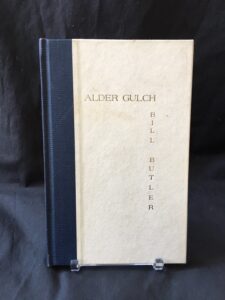
Bill Butler , owner and operator of the Unicorn Bookshop in Brighton, in addition to writing poetry was prosecuted for obscenity in the UK after printing J.G. Ballard’s “Why I Want To Fuck Ronald Reagan” in 1968. Originally from Spokane, Washington, Butler had moved to Britain in 1965, establishing himself as a staple of the growing hippie counter culture, selling books on poetry, mysticism, the occult, drugs, and other topics. In publishing Ballard’s parodic pamphlet — written in the form of a satirical research paper on a sex study involving Ronald Reagan masks — Butler helped launch the career of the writer who would go on to write Crash and High Rise at the cost of his own.
On January 16, 1968, British police raided the Unicorn Bookshop, seizing thousands of titles including works by Burroughs, Ginsberg and others, as well as the business’ cash. Charged with “possessing obscene articles for publication for gain” Butler’s August 1968 trial ended in his being saddled with 3000 GBP in debt, the equivalent of $60,000 USD today, forcing the closure of the Unicorn and his departure from Bristol.
Visiting his home state the following year, Butler met calligrapher and bookseller Steve Herold, later a member of the Asparagus Moonlight Group, who (with Rod Oleson) created this special pirate edition of his first book In Progress, originally published by the Haunted Bookshop in 1961, by xeroxing every page.
As Herold’s inscription explains, this book is one of two which “exists so that Bill Butler could have his own copy of this book &, not always having to sell his copy”.
Butler died in Wales, UK a few years later at age 44.
8vo, 45pp, white cloth boards with blue cloth spine. Title gilt to front board and spine. Minor soiling with some spots to front and back boards. Back board rubbed. Some toning to pastedowns. Long calligraphic presentation inscription on front free endpaper. Very good condition.
$1000
Candela, Rosario. The Military Ciphers of Commandant Bazeries : An Essay in Decrypting. New York : Cardanus Press. 1938. First edition.
“Cryptograph…itis, we are borrowing the word from Bazeries himself — it is a sort of subtle, all pervading incurable malady.”
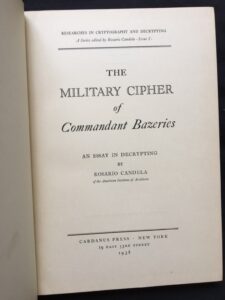
An unusual explanation and examination of cryptography by New York architect Rosario Candela utilizing the supposedly unbreakable ciphers of French Commandant Bazieres. A historical researcher as well as a military officer, Bazeries was the author of the highly influential codebreaking book Les Chiffres Secrets Devoiles, the first known person to break the “Grand Chiffre de 1691” code utilized by King Louis XIV, and a critic of historical and current French encoding methods. (Notably, he blamed Napoleon’s loss at Waterloo on his poor code craft).
In 1898, Bazeries proposed the French military adopt his unique method of creating ciphers using only pencil, paper, and a keyword, offering them some test examples. Furious that the government rejected his code for lack of security despite being unable to solve it themselves, Bazeries published his proposed method and a group of four ciphers, the last of which was unsolved until this English language translation and criticism from Rosario Candela.
Candela, a Sicilian immigrant better known for his residential apartment buildings, taught himself cryptography out of a mixture of boredom, curiosity, and the stagnation of the Great Depression. Self-taught from a variety of French and Italian books he imported from Europe, Candela was a skilled code breaker and manages to provide a thorough overview and analysis of the strengths and weaknesses of Bazeries’ system.
Rosario Candela was so successful in his efforts that he began to teach a class on cryptography at Hunter College in 1941 — the first public course of its type in the United States — and was later tasked with assisting the Office of Strategic Services, OSS, in World War II.
This copy includes three pages of handwritten cryptography work notes including a full page demonstrating the Russian cipher system used on the Eastern Front in WWI, apparently borrowed from “Contributions of the Cryptographic Bureaus In The World War” by Swedish cryptographer Yves Gylden, translated and printed in English in the Navy Signal Corps Bulletin in 1935. These pages are presumably the work of an as-yet-unidentified former owner.
8vo, 137 pp, blue cloth boards with title and author gilt to spine. Bookblock toned with spotting. Some spotting to pastedowns and endpapers, contemporary booksellers sticker and manuscript chart envelope affixed with glue to back pastedown. Envelope contains three printed cardstock decryption keys. Also includes sheets of handwritten decryption efforts on graph paper. Very good condition.
$300
Chideckel, Maurice. Fakers Old And New : History of Cunning and Stupidity. Stratford Co : Boston. 1933.
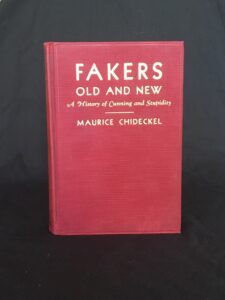
Attractive and well preserved first edition of Fakers Old And New , a highly entertaining and off-color history of con artistry. Arranged geographically and focusing on notable fraudsters and purported holy men from each region. Includes chapters on Joseph Smith and the rise of Mormonism as well as Rasputin in Russia.
This copy formerly owned by Howard Burton MacDonald, three-term member of the Legislative Assembly of Alberta, Canada, and member of the right wing populist Social Credit movement.
Social Credit, the now discredited economic theory of Major C.H. Douglass, argued that the availability of goods and limited purchasing power of individuals had made modern life into a debt trap. Popular in Depression era Canada, Social Credit took root in Alberta thanks to radio promotions by the region’s Premier, William Aberhart, a fundamentalist Christian who claimed bankers were agents of the literal devil.
MacDonald, elected to his first term the year after Aberhart’s death in 1944, was a staunch supporter of the Social Credit Party’s next leader, Ernest Manning, who was briefly able to take the party to national prominence in the 1950s and 60s.
The Social Credit movement in Canada lost popularity due to the rise of anti-banking and anti-Semitic conspiracies among some members — including CH Douglas’ own later work– and the claim by some that it was effectively a nonsensical, conservative cult of personality. MacDonald’s own appearances on the radio throughout the 1950s make sure to mention Manning and the party’s achievements at every opportunity, though he was publicly accused of stealing credit for the Federal government’s response to the 1952 flooding of the Bow River.
8vo, 275 pp, red cloth boards with title and author gilt to front and spine. Corners bumped, wear with losses to top spine and lower board fore corners. Bookblock, endpapers, and pastedowns toned. Pen ownership inscription “The World Awaits You” front pastedown. Some pencil annotations and emphases, pages otherwise clean. Very good condition.
$250
Dolgoff, Sam. The Relevance of Anarchism To Modern Society. Soil Of Liberty. Minneapolis, Minnesota. 2nd edition, September 1979.
The very technology that has opened new roads to freedom has also armed states with unimaginably frightful weapons which could annihilate humanity
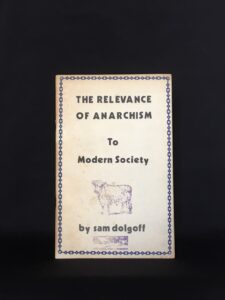
Scarce second edition of the revolutionary tract by Sam Dolgoff on the future of modern anarchism predicting the rise and impact of automation and artificial intelligence. After leaving the Russian empire for New York with his family in 1905, Dolgoff (born Sholem Dolgopolsky) was a house painter in the Bronx at age 11 and continued in the trade for the remainder of his life. An early member of the Young People’s Socialist League, Dolgoff left feeling that other members “regarded the Socialist Party as a vehicle of opportunity that enabled them to run for office, to find sinecures in government agencies and union bureaucracies, and only incidentally to improve the lives of those who voted for them”. Joining the International Workers of the World in 1922, he remained a member until his death in 1990, serving as a writer and editor in various movement related publications like the 1974 anthology, The Anarchist Collectives: Workers’ Self-Management in The Spanish Revolution, 1936 – 1939.
In this work, written in New York in 1971 and first published by the anarcho-feminist Soil Of Liberty Press in Minneapolis in 1977, Dolgoff warns that the bourgeois strain in leftist thought has been the cause of anarchism’s stagnation and looks to the solutions and complications presented with the rise of “cybernation”.
We consider that the constructive ideas of anarchism are rendered even more timely by the cybernetic revolution, still in its early stages, and will become increasingly more relevant as this revolution unfolds. There are, even now, no insurmountable technical-scientific barriers to the introduction of anarchism.
Calling for a return to Kropotkin’s Fields, Factories, and Workshops (1899) and the use of technologically decentralized industry to “achieve a greater balance between rural and urban living” and fulfill the ideal of “from each according to his abilities, to each according to his needs”, Dolgoff also warns against taking too utopian a view. In arguments eerily predictive of data collection, social media manipulation, and even Universal Basic Income, Dolgoff cautions that anarchism’s role is as a guiding compass against the “Establishment” using the technology means of artificial leisure to enslave. This unusual example of the second edition, published in September 1979, features a purple stamped decoration of a cow and field on its wraps appropriately positioned with the title and author. All other examples found in plain white wraps, suggesting this may be an early or even test printing.
8vo, 22pp + 2 ads and references. Staple bound pamphlet with printed card wraps, price 60 cents and mailing address on reverse. Binding variant with purple cow stamp [?]. Wraps spotted with some uneven toning to front wrap. Various pen underlines and emphases. Some pages dogeared. Contemporary booksellers stamp in black ink back wrap interior. Good condition.
$50
Fortune, Jan I. Fugitives The Story of Clyde Barrow and Bonnie Parker as Told By Bonnie’s Mother ( Mrs. Emma Parker ) and Clyde’s Sister ( Nell Barrow Cowan ), Compiled, Arranged, and Edited by Jan I Fortune. The Ranger Press Inc. : Dallas , Texas. 1934. First Edition. First Printing, September 1934.
“There is nothing in these pages which would attract any normal person to the life of an outlaw.”
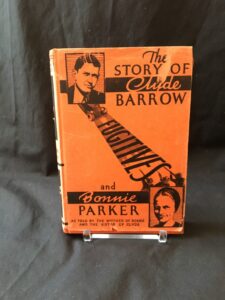
One of the first books to cover the crime spree and subsequent deaths of infamous outlaws Clyde Barrow and Bonnie Parker , Fugitives has been controversial since its release over the exact role played by the Barrow and Parker family’s in its writing. Although credited in many modern sources as having been authored by Bonnie’s mother, Emma Krause Parker, it would be more accurate to place the authorship on Texas Journalist Jan Fortune who interviewed and transcribed the opinions of her subjects. Although Fortune claimed to have observed all tenants of ethical reporting at the time, Nell Cowan, Clyde’s sister and one of the books purported “co-authors” would later argue it was as good as invented. However, it also contains photographs and poetry, allegedly written by Bonnie Parker during their crime spree, given to Fortune by Mrs. Parker. A scarce early piece of American ( and Texas ) 20th century true crime history.
8vo,vi + 255pp, orange cloth boards with minor wear to edges and corners. Black pastedowns and endpapers. Pages clean. Original printed paper dust jacket, price clipped, with minor losses to spine and face edges. Wear from former sticker back flap interior. Very good in a good condition.
$700
Ginsberg, Allen. Howl and Other Poems. City Lights Publishing, San Francisco, 1956. First Edition .
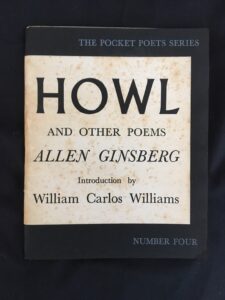
One of the foundational texts of Beat literature, Howl first appeared as “Howl for Carl Solomon” the previous year (1955) in a hand-stapled, mimeographed run of 50. This first edition, first issue of Allen Ginsberg ‘s Howl and Other Poems— recognizable by the dedication to “Lucien Carr” removed in later versions and the mistaken period after Harlem on the back wrapper– served as the centerpiece of considerable controversy, including a landmark Obscenity case.
Originally printed in London, publisher and poet Lawrence Ferlinghetti was arrested after customs officials seized 520 copies for their references to homosexual sex and drug use. Following Ferlinghetti’s acquittal, Howl saw a second print run of 5000 copies to meet demand, making this true first edition of the Ginsberg classic even more difficult to come across.
Small 8vo, 44pp, original printed wrappers as issued. Foxing to front and back wraps. Some small pencil markings to title page but text otherwise clean. Superficial chip to front wrapper at spine. Good condition.
$2500
Hoffman, Abbie. Steal This Book . Pirate Editions, 1971.
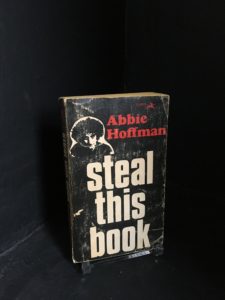
First edition, unstated later printing of the counter-cultural survival manual turned cult-classic by Yippie movement leader Abbie Hoffman. Most famous for their acts of absurdist direct action like the campaign to elect a literal pig for president or nearly causing a riot by raining Monopoly money onto the floor of the New York Stock Exchange, the Yippie ethos was as much a cultivated sardonic prankster attitude making mockery of mainstream society as much as it was a “philosophy”. Steal This Book, with its evocative, imperative, title, serves as an encapsulation of the attitudes, ideas, and techniques from the turbulent immediate post-1960s period, reflected in Abbie Hoffman ‘s inclusion of sections on constitutional law, holding press conferences, stealing food, providing first aid to street fighters, and cartoonish schematic instructions for the creation of Weather Underground-esque improvised explosives.
Small 8vo, 318 pp, printed black paper wraps with original price of $1.95 on front and back wrapper, Grove and Pirate Edition logos in red on spine and front wrapper. Price obscured by marker on front wrap. Wear with color losses to front wrap, some yellowing to back, some creasing to front wrap corners. Reading creases and wear to spine corners. Book block and pages yellowed but clean. Good condition.
$100
Judge. Jr. Here’s How! John Day Publishing : New York, 1927. Third printing, February 1928.
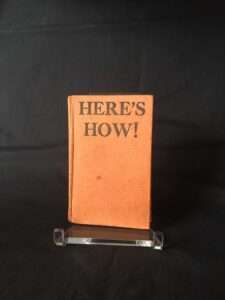
Written in a time of technical illegality and changing tastes, this cocktail recipe book captures several classic drinks in their earliest iterations and provides insights into the conventions of Prohibition era drink making. Notable mentions include the “75 Cocktail”, renamed the “French 75” in the Savoy cocktail guide of 1930, the first English language appearance of “Cointreau”, “Gordon Water” as a euphemism for bathtub gin, and “The FrankenJack” cocktail, immortalizing one of the pseudonymous author Norman Hume Anthony’s favorite New York speakeasies “Frank and Jack’s”.
Hume, a cartoonist and illustrator, was later editor of Judge Magazine and Life Magazine as well as the creator of the depression era weekly magazine, “Ballyhoo”. His other books included “The Drunks Blue Book” and “What to do Until the Psychiatrist comes”.
16mo, 63pp, original orange cloth, minor soiling to boards with cracking along front spine hinge, wear with cloth losses to lower spine. Brown card pastedowns and endpapers. Bookblock spotted. Pages clean. Lacks dust jacket. Good condition.
$300
Knish, Anne [Ficke, Arthur] and Morgan, Emanuel [Bynner, Witter]. Spectra: A Book of Poetic Experiments. Mitchell Kennerley. New York. 1916. First Edition.
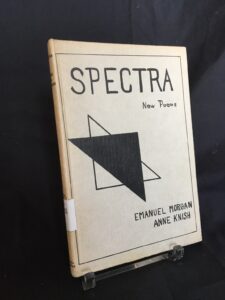
Created as a drunken hoax mocking modern poetry , Spectra is a manifesto and small collection of poems which kicked off the fake-poetry movement, “Spectrism”. In their mid-thirties, poets and critics Witter Banner and Arthur Davison Ficke went through ten bottles of whiskey over ten days in a hotel room creating a fictional poetry school that they felt exemplified all the problems with what they felt to be the experimental and unaesthetic nature of popular modern poetry.
The book sold wildly and earned fans like William Carlos Williams and others before the pair admitted to the hoax in 1918. Unfortunately for both poets, the joke was on them. As one critic in the Little Review wrote, “I confess to a deep ignorance of the nature of the hoax. If a man changes his name and writes better stuff, why does that make the public so ridiculous?” Despite decades of trying, Bynner and Ficke would never write anything as popular in their “real” work as they did with this parody.
Small 8vo, 66pp, original printed grey boards with title, authors, and image in black. Ex-library copy with UC Santa Cruz Library plates on front pastedown and back free endpaper. Former owners inscription on first free endpaper. Original poem by former owner dated 1918-1919 on back free endpaper. Good condition.
$250
Louys, Pierre. Songs of Bilitis. Parnassian Society : London , 1920. Limited edition, 295 of 300 copies. Ex Libris Victor Schertzinger.
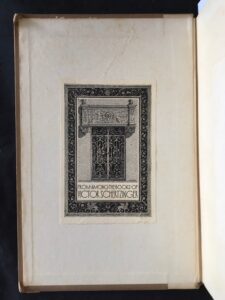
Explained in Pierre Louys’ introduction to have been found carved on tablets of “black amphibolite” in the tomb of its “author”, this collection of 143 poems purports to be the authentic record of the life of Bilitis, an ancient woman of half Greek and Phonecian decent, who studied poetry under Sappho and later became a sacred courtesan to Aphrodite.
An amusingly thorough hoax, Louys’ introduction includes extensive references to other authors and ancient works as well as an extensive bibliographic index. A friend of Andre Gide, to whom this work was originally dedicated, Louys changed his name to Louys with a Y for the “Greek I” (“igrec”), also a symbol of the tri via or three-way road of Hecate. His friendship with Claude DeBussy resulted in the composer’s Chansons des Bilitis for voice and piano. Although in actuality Louys’ own creation, their authentic inspiration, borrowing from the Bucolics of Virgil and other ancient sources is evident, with the collection’s opening moving from an erotic encounter with a tree to an invocation of Pan and Silenus. The poems also inspired one of the earliest lesbian organizations in the United States, the Daughters of Bilitis , founded in San Francisco in 1955.
This copy bears the elegant bookplate of Victor Schertzinger , silent film director and classically trained composer. Director of 103 films from 1917 to 1942 he was one of the earliest directors to utilize technicolor and also the only director of the silent era with classical music training, as highlighted in his adaptation of Gilbert and Sullivan’s The Mikado (1939). His original compositions for film such as “I Remember You” (1941) have had lasting impact (including a Beatles cover in 1962). He died unexpectedly of a heart attack in 1942 and is memorialized with one of the earliest Hollywood Walk of Fame stars.
Six copies of this edition found in OCLC as of June 2021.
8vo, 169 pp + [3] index. Brown paper boards with white cloth spine. Corners bumped. Corners, edges, and spine ends rubbed. Minor soiling and bruises to back board. Endpapers and pastedowns spotted, bookplate of Victor Schertzinger front pastedown. Hand numbered 243 of 300 front half-title verso. Pg [xiv – xv] uncut. Some pages dog eared. Evidence of bookplate or sticker to Index title margin. Good condition.
$550
Mason, Alphaeus Thomas. Brandeis and The Modern State. National Home Library Foundation : Washington, D.C. 1936. Inscribed by editor to journalist Rodney Dutcher.
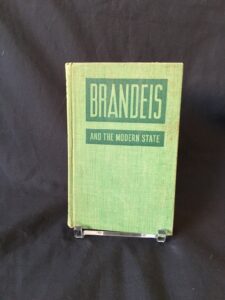
Inscribed on first free endpaper by editor Sherman Mittell to National Enterprise Association columnist and DC Bureau Manager, Rodney Dutcher . Mittell’s note sarcastically references the contemporaneous publication of “The Nine Old Men” by Drew Pearson and Robert Allen.
Dutcher , a noted D.C. circuit reporter of his day, died in 1938 at age 36. As a journalist, Rodney Dutcher is best remembered for his reporting on the Death of Huey Long, his participation in President Herbert Hoover’s 1928 Good Will Tour, and for his less than flattering appearance in the memoirs of Frances Perkins:
“I couldn’t see a different newspaper man every day for long interviews. It was really very pressing. I remember I got into great trouble. One man whom I had never heard of called up and asked for an interview. My secretary asked me about it. His name was Rodney Dutcher and he’s dead now. I’d never heard of him. I had given an interview to somebody the day before, and somebody else the day before that, this was a terrible day, and I told my secretary to say that I absolutely couldn’t do it. I had no time and it was out of the question.
He apparently went off furious. He went to the Press Club and told everybody. Ruth Finney, whom I had become acquainted with, came over to see me and said, “I don’t believe you know who Rodney Dutcher is.”
I said, “I certainly don’t. I never heard of him.”
“Wall,” she said, “don’t ever let him know that you never heard of him. He’s a very sensitive lily. He doesn’t think there could be anybody who doesn’t know who Rodney Dutcher is.”
8vo, 267pp+ 1 ad, green cloth boards. Minor soiling to front and back boards, wear to corners and spine edges. Spotting to back board. Pastedowns and endpapers toned, front free endpaper with presentation inscription in pen. Small stains to book block affecting margins p 245 on. Good condition. Lacking dust jacket.
$100
Early Forensics Archive of Original Crime Scene Photographs from Detective Luke May’s Investigation into the Erland Point Hammer Murders.
“Before [the detective] can successfully conduct a search for evidence, he must know what he is searching for.”
— Luke S. May, 1933
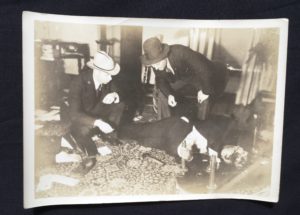
A rare insight into the origins of modern forensics, these prints formed part of the evidence used by the Kitsap County Sheriff’s Office and Private Detective Luke S. May in the investigation of the infamous Erland Point Massacre, or, the Erland Point Hammer Murders.
On the morning of April 1, 1934, barking dogs left locked in the car outside 5617 Erland Point Road in Bremerton, Washington alerted neighbors to a horrifying Easter Weekend surprise. Inside, were the ruins of a card game and a terrible struggle that had left the owners of the home and four other locals bound, gagged, and beaten to death with a variety of implements. Shortly after the Kitsap County Sheriff’s office secured the scene, the private consulting detective known as “America’s Sherlock Holmes” arrived by ferry to guide the investigation.
Inspired at an early age by Arthur Conan Doyle’s stories, May taught himself German as a teenager to read some of the first works on criminal psychology, eventually working his first murder case at 16. By 22, he had opened the Revelare International Secret Service, working with a team of early forensics experts to solve cases from document forgery, cattle theft, and murder. In addition to his 1933 instructive Scientific Murder Investigation and Field Manual of Detective Science, May was also the author of 1936’s Crime’s Nemesis and a regular contributor to True Detective Mysteries magazine.
These arrestingly framed but brutal original crime scene photographs represent the meticulous documentation May insisted on in investigations, relying on camera angle and perspective to approximate placement of blood splatter and debris. May’s obsession with optics carried over to his signature invention, the Revelarescope, or comparison magnascope.
Invented in 1922, but patented the same year as the massacre, the Revelarescope was an enormous, human sized microscope with multiple lenses which projected these images into a large viewing port. Utilized for document analysis, studying knife marks, and comparing photograph details, the sole example was last seen at a Seattle auction in the 1960s, but anticipated many of the techniques and tools familiar in modern practice and popular culture.
With each of the larger interior photographs labeled by room and victim name, it seems likely that these were some of the actual images to go under Luke S. May’s lens.
The only other known Erland Point original crime scene photographs were those published in the Seattle Post Intelligencer, examples of which are now held at the Museum of History and Industry in Seattle, Washington.
13 sepia tone gelatin silver photographs. Four exterior shots at smaller 2 x 4 inches. Nine interior shots with pencil annotations of “C. Olympic Jones” and notes in an unknown hand, 5 x 7 inches. General curling, some examples with darkened spots at edges. Minor folds at corners with only small house exterior having more than one fold on the image face. Good condition.
$950
Marston , William Moulton. The Lie Detector Test. Richard R. Smith, New York, NY. 1938. First edition.
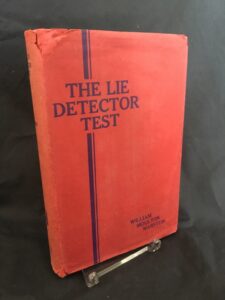
This early work on the lie detector by its inventor William Moulton Marston explains the development and use of early polygraph machines in business, science, and the court of law.
A landmark in early scientific true crime books this work includes a discussion of Marston’s work interviewing suspects in the Lindbergh Kidnapping case, ultimately “solved” utilizing handwriting analysis. Marston, in addition to being an early feminist, lived with his wife Elizabeth Marston (to whom this book is dedicated) and their lover Olive Byrne.
Both women, the polygraph and Marston ‘s predilection for bondage served as inspirations for his comic creation Wonder Woman and her lasso of truth.
8vo, 179pp + 3 index, red cloth boards with title and author’s name gilt embossed to front board. Title, author, and publisher gilt on spine. Small discoloration at top hinge corner of front board. Faded water stain at top of back board. White stain to interior corner of top bookblock edge. Pages clean with 8 black and white diagrams and photo plates. Good condition. Red paper wrappers with title and author printed in blue on front with decorative pinstripe. Minor losses at fore-edges and top and bottom spine. Patch of water damage on back wrapper. Wrinkling at edges, some fading at fore folds. Edges price-clipped but shows the original “$2.00” price on fore flap. Good condition.
$350
Proclamation of the Inciting Incident of Hertell v. Bogert 1841, an early 19th-Century New York Real Estate Scandal.
New York, 1822, Broadside.
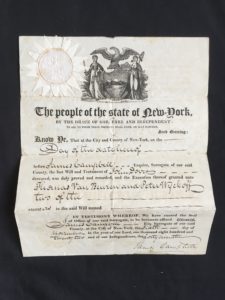
In this document, New York County Surrogate James Campbell certifies that the will of John Dover, a wealthy New York city landowner killed by the Yellow Fever outbreak of 1822, has been dutifully executed by his lawyers Peter Wyckoff and Thomas Van Beuren.
As noted in surviving newspapers and in New York case law, however, Van Beuren held all of Dover’s properties on Broadway in trust, pocketing all rental money for himself, before finally cutting Dover’s family out of the land’s illegal sale. The resulting case Hertell v. Bogert, between one of Dover’s surviving daughters and the purchaser C.L. Bogert, was decided in the family’s favor in 1841.
8x 11″, printed legal form with a large engraving of New York’s state seal and personal information of the deceased, his lawyers, and the New York County Surrogate. Embossed surrogate seal of New York state affixed to upper left corner. Folded in horizontal quarters, some staining along seams. Good condition.
$300
Peake, R.J. Pitman’s Common Commodities Of Commerce : Cotton From The Raw Material To The Finished Product. Sir Isaac Pitman & Sons, LTD : London. Undated [c. 1909] . First edition.
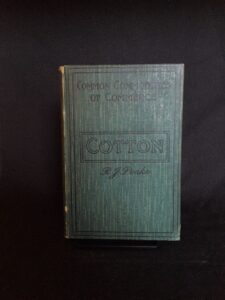
This text explaining the global cotton industry at the start of the 20th century preserves both the state of the trade before the spread of the bole weevil in the United States and the high watermark of the British Empire ahead of the First World War. In addition to discussing the varieties of cotton grown in different areas of the world and the development and use of numerous labor-saving machines to process it, the book covers the creation of the International Congress of Delegated Representatives of Master Cotton Spinners’ and Manufacturers Association, which held its first meeting in Zurich in 1904.
This copy was formerly owned by Columbia University Professor James Chittick, author of Silk Manufacturing and Its Problems (1913) and frequent New York expert in court proceedings involving textile imports and manufacture.
Although most commonly called to testify in cases involving garment companies, Chittick was also the defendant in a 1916 case accusing him of abusing his position as treasurer to defraud the recently created British War Relief Association. Ultimately dismissed later the same year, the accusation appears to have covered over the Association’s other legacies. The first War Relief association to be incorporated in New York City which “collected for the purchase of hospital supplies, clothing, surgical dressings, etc., more than $100,000″ along with textile donations has become a forgotten footnote from the period with its name more closely associated with other groups using the same designation during the Second World War.
Small 8vo, 122pp + 4pp index + 2pp map + 16pp ads, patterned cloth boards with title and author tool stamped. Corners bumped, wear to top and bottom spine. Wear along front spine joint. Penmark to front pastedown. Dated 1918 ownership signature and later bookseller sticker on front free endpaper. Bookblock and pages toned. Illustrated with color frontispiece, 17 black and white photographs and diagrams, and a two page map of world cotton production. Good.
$100
Pollock, Frederick. Leading Cases Done Into English and Other Diversions. Macmillan and Company : London. 1892. First Collected Edition.
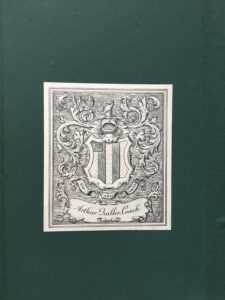
Expanding upon an earlier edition published in 1876, Leading Cases and Other Diversions is an unusual poetic parody law book by British jurist and legal historian Sir Frederick Pollock dedicated to the poet Charles Algernon Swinburne.
The first half takes inspiration from notable legal incidents and landmark rulings in British during the 18th and 19th centuries with Pollock’s poetic adaptations peppered by footnotes featuring excerpts from the cases in question. The second half is given over to the titular diversions, Pollock’s translations of Greek poetry and compositions in several languages.
This dual association copy is marked with the bookplate of the Cornish writer Sir Arthur Quiller Couch, editor of The Oxford Book of English Verse 1250-1900 with his motto “Do and Abide” as well as the ownership signature of Walter K. Firminger, historian and archdeacon of Calcutta, from his time at Oxford’s Merton College.
Small 8vo, 98pp + 2 ads, blue cloth boards with title and author gilt. Corners bumped, small bubble to front board, wear to board edges with bruising to bottom of front board. Spine darkened with wear to ends. Small scuff to back board. Book block darkened. Green card pastedowns and endpapers with the library stamp of A.Q. Couch on front pastedown with contemporary bookseller’s sticker below. Ownership signature from Walter K Firminger on third free endpaper. Pages clean. Binding split page 48 – 49. Good condition.
$100
Rajneesh, Bhagwan Shree. Subhuti, Anand, Forward. The Goose Is Out. Rajneesh Foundation International, Antelope, Oregon. 1982. First edition with corrective label.
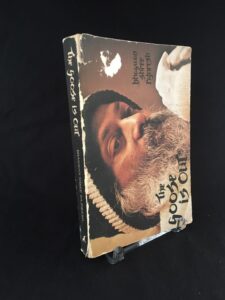
This is a first edition record of a Zen inspired lecture series by Bhagwan Shee Rajneesh , later known as Osho, and was his last delivered ahead of his move to the United States and the establishment of his planned community Rajneeshpuram outside Antelope, Oregon in 1981. Printed in Antelope the following year, this book stems from the period depicted in the Netflix series Wild Wild Country where escalating tensions between the Rajneesh Foundation International, or “Rajneeshis”, and their rural Oregon neighbors escalated into active resistance, an assassination attempt, and the biggest incident of bioterrorism in US history.
Although criticized by observers for his other perceived tactics– including accepting lavish gifts and driving a Rolls Royce– Rajneesh avoided responsibility in these incidents thanks in large part to a conveniently timed vow of silence. Although defenders argue that this vow was an unrelated ascetic commitment begun before leaving India, the details of this book suggest there was some confusion over the reasons and duration of his silence. In addition to being a first edition, this copy bears an adhesive label on its back wrapper, presumably added by adherents, which reads “The last lecture series before Bhagwan stopped speaking for an indefinite period,” and covers over the original copy “The last lecture series before Bhagwan stopped speaking forever,” and another line that called the title a “must have”. It is unknown how many copies were corrected in the same fashion.
8vo, 286pp + 11ads, flexible card stock boards with attached printed paper wraps. Apparent tape damage to front wrap, wear to wrap edges with losses and some tearing along front spine joint. Minor soiling to back wrap and book block. Black adhesive label appended to back wrap. Small moisture stain to back board bottom fore corner. Original $10.95 price sticker on front free endpaper. Pages clean. Dogearing to pages 169 to 176. Good condition.
$45
Robertson, John Parish and William Parish. Letters on Paraguay: Comprising an Account of a Four Years’ Residence in that Republic, Under the Government of the Dictator Francia. Philadelphia, E.L. Carrey & A. Hart, 1838.
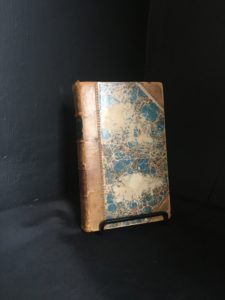
“Paraguay is less known, perhaps, to the English reader than any other part of the world into which European Civilization has been introduced.”
Arriving in Buenos Aires and traveling overland to Itapua, Paraguay this epistolary travelogue by two Scottish brothers takes a turn at the end of volume one. Leaving on a river trip after a celebration of the Feast of St John the Evangelist with local Jesuits and their parishioners, the authors return to find the country’s leader Don Gregario overthrown and the priests expelled under the arguable Latin American Robespierre, Jose Gaspar Rodrigo Francia. Titled “The Supreme and Perpetual Dictator of Paraguay” following his rise to power in 1814, the former lawyer turned dictator Francia was popularly called “El Supremo”, ruling until his death in 1840. A fascinating first-hand account of a turbulent, revolutionary period at the twilight of the Spanish empire with descriptions of geography, customs, politics and more.
First US edition printed by E.L. Carrey and A. Hart of Philadelphia shortly after the original publication in London. Possibly the personal copy of British ex-pat and New York Herald Tribune writer, A. E. Coleman, whose collection is held at the University of Toronto. Tentative verification with archival staff of the E.J. Pratt via email due to COVID-19.
8vo 236pp + 220pp, two volumes bound together. Three quarter tooled leather over marbled boards, title and author gilt on spine. Some, scuffing, and wear to edges and faces. Marbled pastedowns and endpapers. Former ownership signature on second free endpaper. Top of title page clipped, with minor marks in margin. Occasional foxing. Pages aged but clean apart from darkening of title page and contents in Volume II. Good condition.
$750
Shelley, Percy. Queen Mab A Philosophical Poem With Notes. John Brooks, London. 1829.
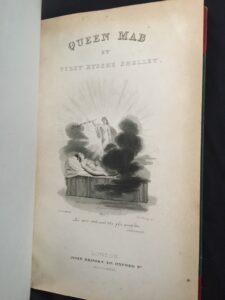
Percy Shelley’s first published work, Queen Mab (1813) served as a lyric treatise for his own developing philosophical sentiments which included radical sociopolitical positions for the period such as atheism. Considered by the author to be too unpolished for publication, of the original 250 copies printed in London by William Clark, only about a third entered circulation among Shelley’s friends and other poets, before it was reworked into The Daemon of The World in 1816.
In 1821, the remaining signatures of Queen Mab were rediscovered, with Clark passing along copies for resale to other booksellers. When news of the sale of these copies, distinguished by the later date and inclusion of the original inscription to the poet’s first wife Harriet, Shelley wrote the following public plea for its suppression to London’s Examiner newspaper on June 22:
I doubt not but that it is perfectly worthless in point of literary composition; and that, in all that concerns moral and political speculation, as well as in the subtler discriminations of metaphysical and religious doctrine, it is still more crude and immature. I am a devoted enemy to religious, political, and domestic oppression; and I regret this publication, not so much from literary vanity, as because I fear it is better fitted to injure than to serve the sacred cause of freedom.
Unable to have the sales declared illegal, Shelley’s efforts to criminalize the pirate copies eventually landed Clark in prison for “the publication of blasphemous libels” in December of 1821. The “victory” proved short lived when Shelley died on June 22, 1822.
Although Percy Shelley’s actions and his father’s interference in Mary Shelley’s editing and publishing of his remaining works kept Queen Mab from official, unrevised rereleases, public hunger for Shelley’s poems fueled a small industry of producing and selling further illegal copies based on Clark’s original signatures.
This pirate edition of Queen Mab produced in 1829 by publisher John Brooks is particularly interesting for its insights on pirate editing of the period and the growing cult of Shelley after his death. It combines the original dedication “To Harriet” with a memorial frontispiece showing Shelley’s corpse attended by a muse before a funeral pyre.
8vo, 223pp, three-quarter bound with green boards and red leather spines. Edges rubbed with some leather loss. Raised bands, with gilt decoration on spine, covers with three rules and dentelles, marbled endpapers. Spine hinge of front board fragile, incomplete separation at top most and bottom most sections. Some chipping on spine. Complete with frontispiece showing Shelley’s funeral pyre. Contains dedication to Shelley’s first wife Harriet removed in later editions. Pages clean. Good condition.
$800
Wright , Willard. Misinforming A Nation . BW Huesch : New York. 1917. First Edition.
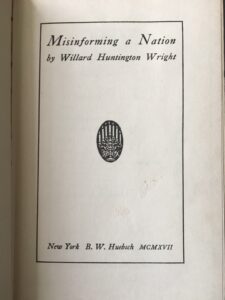
An unusually impassioned book on what would be a dull subject for many, Misinforming A Nation was written by Willard Wright (who later wrote under the pen name SS Van Dine ) just as the United States entered World War I. Calling the Encyclopedia Britannica a kind of “intellectual colonization”, Wright accuses the editors of intending to skew American public opinion toward Britain and away from other nations like Germany by overemphasizing or omitting various entries. Arguing that Americans prize British culture among all other European ones, Wright suggests that this is an inherited and intentional deception that locks the United States into negative self-comparisons with its former ruler.
Accused of being a spy for Germany in November 1917, Wright’s opinions on the war — and those laid out in this book — lead to the downfall of his career under his own name, the end of his friendships with H.L. Mencken and Theodore Dreiser, and his subsequent mental breakdown.
8vo, 222pp, burgundy cloth boards. Spine crumpled, wear to board edges, small nick to back board fore edge. Back board curved, bruise to lower edge. Contemporary ownership signature to first free endpaper. Some pencil underlines and annotations, including note on first endpaper following index. Good condition.
$200

